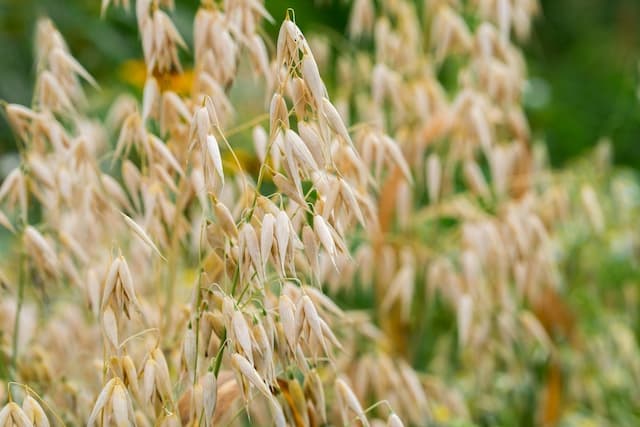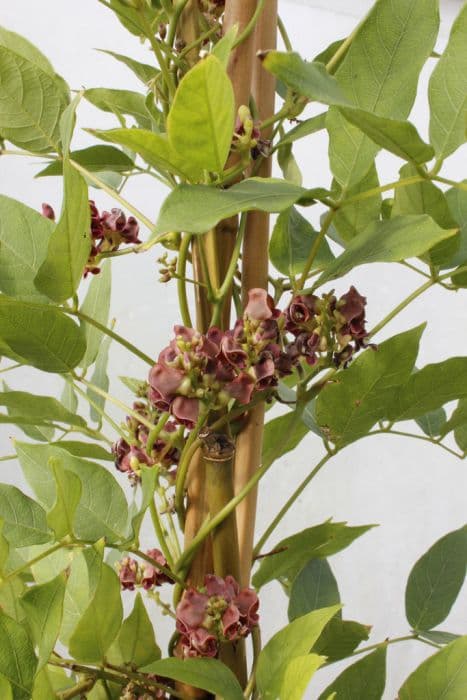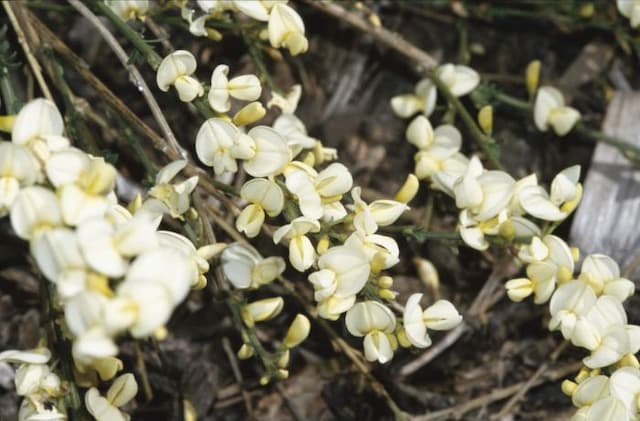Black Broom Cytisus nigricans 'Cyni'

ABOUT
The plant commonly known as Black Broom or Cytisus nigricans 'Cyni' has a distinctive appearance that comprises various features. Its branches are typically covered with small green leaves that may have a slightly grayish tone, giving the plant a fine-textured visual character. During the blooming season, it produces an abundant display of vibrant yellow flowers, which are quite striking against the green backdrop of the foliage. These blooms are pea-shaped, a characteristic appearance for flowers in this plant group, and they are often clustered together, creating dense, eye-catching clusters. The overall visual effect of the Black Broom during flowering is quite ornamental, making it a popular choice in garden settings for its color and form. Despite this description, details concerning the specific size of the plant, in terms of its dimensions, are not provided here.
About this plant
 Names
NamesFamily
Fabaceae.
Synonyms
Black Broom, Austrian Broom, Blackwood Broom.
Common names
Cytisus nigricans 'Cyni'.
 Toxicity
ToxicityTo humans
The plant commonly known as broom is considered to have a level of toxicity to humans. If ingested, parts of the broom plant can lead to various symptoms of poisoning such as nausea, vomiting, and diarrhea. In severe cases, it can cause heart problems and convulsions. It is advised that humans avoid consuming any part of the broom plant due to these potential health risks.
To pets
The broom plant also poses a risk of toxicity to pets. Ingestion of the plant can result in similar symptoms to those experienced by humans, such as gastrointestinal upset including vomiting and diarrhea. More severe reactions may involve heart issues and possibly seizures. Pet owners should prevent their animals from ingesting any part of the broom plant to avoid these possible consequences.
 Characteristics
CharacteristicsLife cycle
Perennials
Foliage type
Deciduous
Color of leaves
Green
Flower color
Yellow
Height
3-4 feet (0.91-1.22 meters)
Spread
3-4 feet (0.91-1.22 meters)
Plant type
Shrub
Hardiness zones
6
Native area
Europe
Benefits
 General Benefits
General Benefits- Landscape Ornamentation: Cytisus nigricans 'Cyni', also known as Black Broom, adds vibrant yellow flowers to gardens, which can enhance the aesthetic appeal of the landscape.
- Drought Resistance: Black Broom is known for its ability to withstand periods of drought, making it suitable for xeriscaping and low-water gardens.
- Erosion Control: Its root system helps stabilize soil on slopes, preventing erosion.
- Wildlife Attraction: The flowers attract pollinators such as bees and butterflies, supporting local biodiversity.
- Low Maintenance: Black Broom is relatively easy to care for and does not require frequent watering or fertilization once established.
- Fast Growth: It grows quickly, which can be advantageous for creating screens or hedges in a short amount of time.
- Nitrogen Fixation: As a member of the legume family, it has the ability to fix nitrogen in the soil, improving soil fertility for other plants in the vicinity.
 Medical Properties
Medical PropertiesThis plant is not used for medical purposes.
 Air-purifying Qualities
Air-purifying QualitiesThis plant is not specifically known for air purifying qualities.
 Other Uses
Other Uses- Dye Production: The plant can be used to produce yellow dyes due to the presence of natural pigments in its flowers and stems.
- Tannin Source: Cytisus nigricans 'Cyni' contains tannins in its bark and leaves, which can be used in the leather tanning process.
- Soil Stabilization: Because of its robust root system, it is often planted to prevent soil erosion on slopes and embankments.
- Biomass Fuel: The dense growth of Cytisus nigricans 'Cyni' makes it a potential source of biomass for renewable energy production.
- Insect Repellent: The aromatic properties of the plant can repel certain insects, making it a useful companion plant in gardens.
- Garden Ornamental: Often used in landscaping for its bright flowers and as a border plant due to its compact growth habit.
- Livestock Bedding: The branches and leaves, when dried, can provide bedding material for livestock, offering a comfortable and absorbent resting place.
- Intercropping: Used in agricultural systems among crops to improve soil nitrogen levels, as it is a legume capable of fixing nitrogen.
- Natural Fencing: Its dense growth can form an effective hedge or natural barrier for property lines or to enclose livestock areas.
- Photographic Subject: The vibrant yellow flowers make it a popular subject for photography, especially in natural landscape settings.
Interesting Facts
 Feng Shui
Feng ShuiThe Black Broom is not used in Feng Shui practice.
 Zodiac Sign Compitability
Zodiac Sign CompitabilityThe Black Broom is not used in astrology practice.
 Plant Symbolism
Plant Symbolism- Protection: The Black Broom or Cytisus nigricans 'Cyni' is often associated with protection. In folklore, brooms were believed to ward off evil spirits and negative energies.
- Humility: Throughout history, brooms have been tools for the common household suggesting humility and service, symbolizing the virtue of being grounded and humble.
- Purification: Black Broom is sometimes used in rituals or ceremonies as a symbol of purification, utilized in clearing spaces of negativity much like its practical use in cleaning.
- New Beginnings: Since brooms are associated with cleaning, they naturally come to represent sweeping away the old to make room for new beginnings and fresh starts.
 Water
WaterThe Black Broom (Cytisus nigricans 'Cyni') prefers to be watered infrequently but deeply to encourage strong root growth. It is important to let the soil dry out between waterings. During the growing season, watering once every 1 to 2 weeks with approximately 1 gallon of water should be sufficient, depending on the weather conditions. In hotter, drier periods, you may need to water more often, ensuring that the soil doesn't stay soggy. In the winter months, reduce watering to once a month or less, as the plant is dormant and requires less moisture.
 Light
LightThe Black Broom thrives in full sun exposure. It should be placed in a location where it can receive at least 6 to 8 hours of direct sunlight daily. Avoid shaded areas as insufficient light can lead to poor flowering and leggy growth. The ideal location is one that mimics its natural Mediterranean environment, offering ample sunshine.
 Temperature
TemperatureThe Black Broom is adapted to a Mediterranean climate and favors a temperature range typically between 50°F and 75°F. While it can withstand temperatures as low as 20°F, it's important to protect it from extreme cold. It is most vigorous and blooms best when the temperature stays within the ideal range, but it can adapt to warmer temperatures as long as the other conditions like watering and light are met.
 Pruning
PruningPruning Black Broom is essential to maintain its shape and promote healthy growth. Pruning should be done just after flowering, typically in late spring or early summer, to encourage new growth and flower bud formation for the next season. Cut back the flowering stems by about one-third, and remove any dead or diseased wood. Avoid heavy pruning as this can damage the plant.
 Cleaning
CleaningNot needed
 Soil
SoilAustrian Broom (Cytisus nigricans 'Cyni') thrives in well-draining sandy to loamy soil, enriched with organic matter. A pH between 6.0 and 7.5 is ideal. Amend the soil with compost before planting to improve fertility and structure.
 Repotting
RepottingAustrian Broom rarely needs repotting as it is primarily grown outdoors and develops deep roots. Repot young plants every 2-3 years to encourage growth.
 Humidity & Misting
Humidity & MistingAustrian Broom prefers a dry to moderate humidity environment and is quite tolerant of low humidity levels, making it well-suited for most outdoor conditions.
 Suitable locations
Suitable locationsIndoor
Place in bright, indirect light and avoid overwatering.
Outdoor
Plant in full sun with well-draining soil; water sparingly.
Hardiness zone
6-9 USDA
 Life cycle
Life cycleThe Cytisus nigricans 'Cyni', commonly known as Black Broom, begins its life as a seed, typically germinating in the spring after a period of cold stratification, which breaks the seed's dormancy. Once germinated, the seedling grows into a small shrub, establishing a root system and producing compound leaves. During its vegetative stage, the plant focuses on growth and the development of woody stems. After a few years, when mature, Black Broom enters its reproductive stage, producing bright yellow, pea-like flowers in late spring to early summer that are pollinated by bees and other insects. Following pollination, the flowers develop into small pods, which eventually dry and release seeds, ensuring the continuation of the species. The plant may live for several years, with some individuals reaching up to 10 years, and throughout its life it undergoes seasonal dieback in colder climates, regrowing from the base in the following growing season.
 Propogation
PropogationPropogation time
Spring to early summer
Propogation: Cytisus nigricans 'Cyni', commonly known as Black Broom, is a shrub that is often propagated by seed. The most popular method of propagation for this plant is through the sowing of seeds. Seeds should be sown in the fall in a cold frame or a sheltered outdoor bed. The seeds require a period of cold stratification to break dormancy, so the cool temperatures of autumn into winter help achieve this naturally. Once germinated in the spring, the seedlings can be transplanted into individual pots when they are large enough to handle and then later moved to their final growing location. It is important to keep in mind that seed propagation can result in some variability in the offspring.









